A three-day in-person poll of 1,007 students conducted by The University Times in campus and off-campus locations predicts that Kieran McNulty is to be elected President of Trinity College Dublin Students’ Union (TCDSU) on the first count.
Dale O’Faoilléacháin also looks set to be elected Education Officer on the first count, whilst Aoibhinn Ní Lochlainn looks set to storm the three-person welfare race, also likely to be elected on the first count.
President
McNulty is set to take 50.9 per cent of first-preference votes – almost double his nearest competitor – in what appears to be a significant victory for the fourth-year law student and current Citizenship Officer of TCDSU.
Kieran McNulty Elected on the First Count
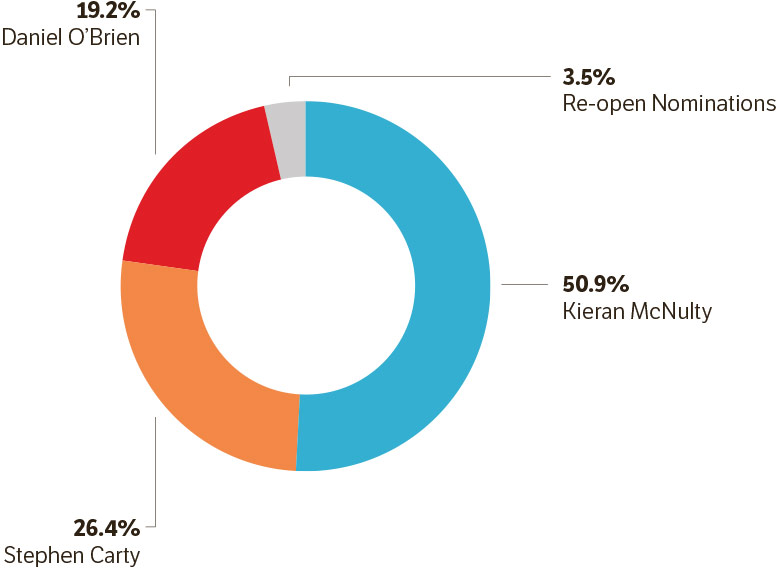
Third-year sociology and social policy student Stephen Carty trails McNulty in second place, with 26.4 per cent of the vote, with fourth-year BESS student Daniel O’Brien trailing further behind in third place, on just 19.1 per cent, with the remainder of the electorate likely to ask the union to re-open nominations. While our poll predicts that McNulty will reach the quota on the first count, further analysis of potential distribution of preferences shows that McNulty looks set to further extend his lead if it goes to a second count, with McNulty receiving roughly double the amount of Carty’s second preferences after the elimination of O’Brien.
Further analysis of data collected shows McNulty in a dominant position in the polls across multiple college cohorts, with more than half of those in both the Faculty of Engineering, Maths and Science (EMS) and the Faculty of Health Science (HS) intending to give him their first preference (53.2 percent and 54.4 per cent respectively). He also has the support of just below half of students in the Faculty of Arts, Humanities and Social Sciences (AHSS), at 48.7 per cent. Daniel O’Brien can be seen to be performing particularly poorly outside of AHSS, his home constituency, with extremely low totals of 11.2 per cent and 12.6 per cent in EMS and HS respectively – a contrast to his more credible showing of 24.8 per cent in AHSS. Carty, on the other hand, puts in a better show across campus – albeit still significantly behind McNulty – with totals of 23.1 per cent, 32 per cent and 29.1 per cent in AHSS, EMS and HS respectively.
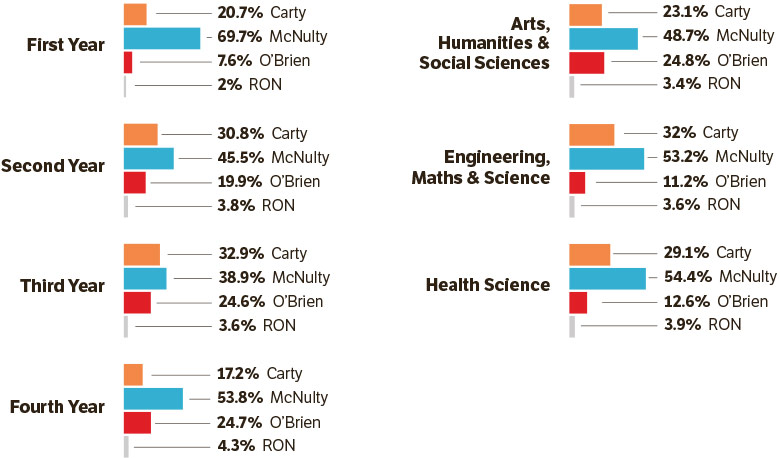
McNulty continues his strong form across year groups, when the votes are broken down into the four main categories – with the main exception being third-year students. In this cohort, the gap between himself and Carty is just merely six percentage points. McNulty asserts his dominance across all the other year groups – with 49 and 14.7 percentage point leads over Carty amongst first and second-year students respectively, showing the effectiveness of McNulty’s campaign in securing the votes of the younger students on campus. McNulty significantly outperforms O’Brien in their own final-year cohort, with 53.8 per cent, more than double O’Brien’s 24.7 per cent.
Interestingly, supporters of McNulty appear to be more satisfied with the overall running of TCDSU – with approximately 41 per cent of McNulty’s voters giving a 4 or 5 on a scale of 1–5 when asked about how satisfied they were with the current sabbatical team, while only 13 per cent of his supporters were dissatisfied (scores of 1–2). This is rather interesting when contrasted with O’Brien’s supporters, approximately 21 per cent of whom identified as dissatisfied with the current sabbatical officer team. Carty on the other hand appeared more in the middle of his two competitors, with 51.5 per cent of his voters neither satisfied or dissatisfied and a very slight skew towards satisfaction. Indeed, the overall results to date appear in line with the fact that McNulty has extensive experience in the union.
The results are an impressive testament to McNulty’s campaign and suggest a potential for a resounding victory next Thursday night, and a significantly shorter count than last year’s marathon. Overall, the results suggest that O’Brien failed to mobilise his campaign team outside of the Arts Block in the same way that the other candidates did, and didn’t jump on the momentum that last Monday’s Dining Hall hustings could have given him. This left ample opportunity for Carty’s team to overtake O’Brien’s, maintaining a consistent presence in the Arts Block and Hamilton throughout the week as well as boosting his online performance by releasing a graphic promising to donate €5,000 of his salary to the Trinity Access Programme. Carty’s lead over O’Brien is not extremely large, and the seven percentage point difference easily arose from Carty’s Tuesday and Wednesday performances.
O’Brien and Carty have their work cut out for them if they are to overcome what may be an insurmountable lead for McNulty. The University Times prediction models always exclude undecided voters – of which there were around 37 per cent – and take into account that such voters normally split marginally in favour of the leading candidate. Even without taking this into account, it would take a major change in the momentum of the campaign for there to be any major difference in the overall results.
Education
Dale O’Faoilléacháin looks set to be elected Education Officer on the first count over opponent Patrick Higgins, with 65 per cent of the vote. Higgins is expected to receive just 32.4 per cent, with 2.7 per cent voting to re-open nominations.
O’Faoilléacháin Elected on the First Count

The second-year physiotherapy student scored a huge proportion of the Health Science vote, taking a strong 83.3 per cent of first preferences, reflecting his extensive time spent canvassing in Tallaght and St James’s Hospital. He also holds the majority of votes in the remaining faculties, receiving 65.22 per cent in EMS and 59.43 per cent among AHSS students. Despite focusing strongly on the Health Science areas, O’Faoilléacháin’s success in the Arts Block can be attributed to his large and extensive presence in the area.
History and political science student Patrick Higgins polls well in AHSS. However, his 38.36 per cent of the vote is not enough to gain full support. Higgins fares poorly among health science students, an unsurprising conclusion given his opponent’s position as the TCDSU Health Science Faculty Convenor. Given this, however, O’Faoilléacháin’s lead over Higgins is not as large as was expected, reflecting Higgins’s good performances at both evening hustings last week.
In the breakdown of votes over the years, O’Faoilléacháin fares best among second years, taking 70.56 per cent of their first-preference vote. This is perhaps partly due to his JCR Sports Officer experience, which would have made him known amongst the 1,000 Trinity Hall students in the year below him. He polls weakest among fourth-year students, yet still walks away with a strong 56.41 per cent of their vote. Higgins, on the other hand, demonstrates the opposite, with his highest vote taking among fourth years at 41.03 per cent, and his lowest at 26.9 per cent of first preferences among second years.
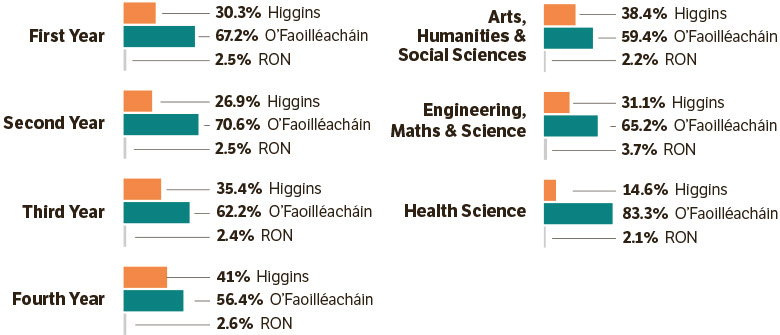
Those giving O’Faoilléacháin their first preference vote tend to be more satisfied with the union than those voting for Higgins. 40.1 per cent of those voting for O’Faoilléacháin stated that they were satisfied with the current sabbatical officer team, whilst 32.3 per cent voting for Higgins were satisfied. 5.6 per cent of students voting for O’Faoilléacháin state that they were dissatisfied with the current team. 5.4 per cent of those voting for Higgins share the same sentiment.
O’Faoilléacháin’s success in the education race is propped up by his TCDSU experience, the usefulness of which was widely debated throughout the campaign period. His large on-the-ground presence along with his consistent performances at hustings put him a cut above Higgins, proving him to be the most experienced candidate for the role.
While again, our prediction model excludes undecided voters like in previous years, and takes into account that they are either unlikely to vote or likely to split marginally in favour of the leading candidate, nearly 43 per cent of those were undecided about who to vote for.
Welfare & Equality
Third-year medical student Aoibhinn Ní Lochlainn looks set to be elected Welfare & Equality Officer on the first count, taking 60.4 per cent of the vote, more than double that of her closest competitor, Éamonn Redmond.
Ní Lochlainn Elected on the First Count
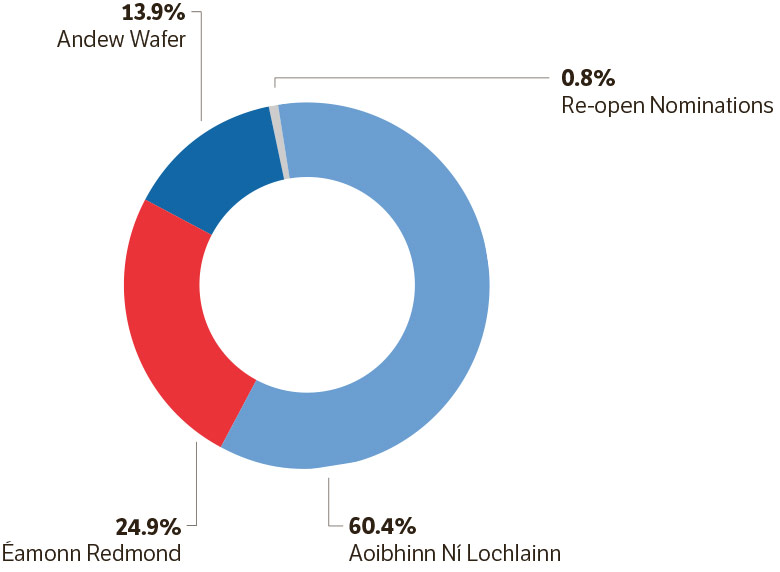
Fourth-year social work student Redmond trails behind with 24.9 per cent, with Andrew Wafer taking just 13.9 per cent. Whilst the poll predicts that Ní Lochlainn will be elected on the first count, if it were to go to a second round, she is likely to take most of Wafer’s second preference votes, gaining nine percentage points of the share of the vote.
Ní Lochlainn is the most popular candidate by far in every year grouping and across every faculty, with 56.5 per cent of the AHSS vote and 61.3 per cent of the EMS vote. In her home HS constituency, she takes a dramatic 73.6 per cent of the vote.
Ní Lochlainn is most popular among first year students, taking 67.8 per cent of their first preference vote. Redmond’s strongest faculty is AHSS, where he holds 29.1 per cent of the vote, a strong lead over Wafer’s 13.6 per cent. He is most popular among fourth-year students, holding 42.7 per cent of their vote – a proportion still lower than Ní Lochlainn’s 49.4 per cent. Wafer, on the other hand, has his strongest vote share in EMS, but fails to make an impression among fourth years, holding just 7.9 per cent of the vote. His low percentage of first preference votes in AHSS is perhaps reflective of his lack of visibility in the Arts Block.
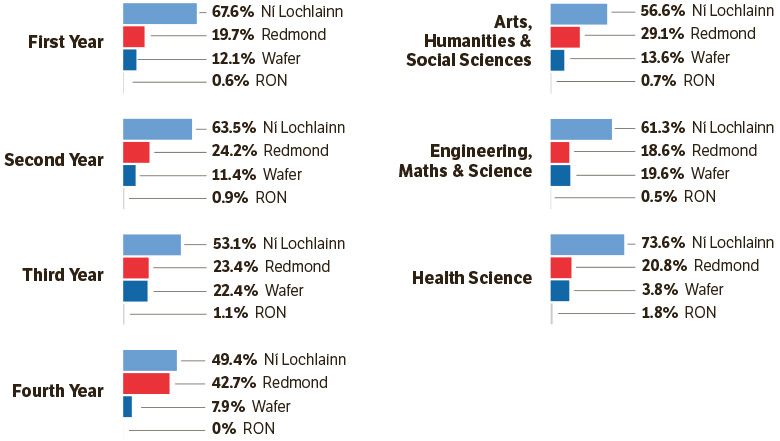
As the welfare race is usually a highly contentious one, it is unusual for one candidate to emerge dominant over the other. Last year saw a five-person race that went into the third count, with a close race emerging between current officer Conor Clancy and Muireann Montague. The previous year saw Ian Mooney beat rival Daniel McFadden by just 73 votes. The strong presence that Ní Lochlainn has had throughout the campaign period along with her welfare committee experience has allowed her to become the first major frontrunner that this position has had in a few years.
Ní Lochlainn’s success also lies in her immense experience with both the Welfare committee and Student2Student support services, and her sincere desire to develop and promote currently underused services such as Peer Support and Niteline.
Communications & Marketing
The communications & marketing race, in its second year, is expected to be closer than last year’s, with fourth-year law student Glen Byrne expected to take 56.7 per cent of the first preference votes over Emmet Broaders, who is set to receive 39.6 per cent. Re-open nominations is expected to not rise far past 3.6 per cent. These results suggest that Byrne is likely to be elected on the first count. Whilst our prediction model excludes the 41 per cent of voters undecided in this race, who are likely to split marginally in favour of front-runner Byrne, this race is one of the closer ones.
Byrne Elected on the First Count
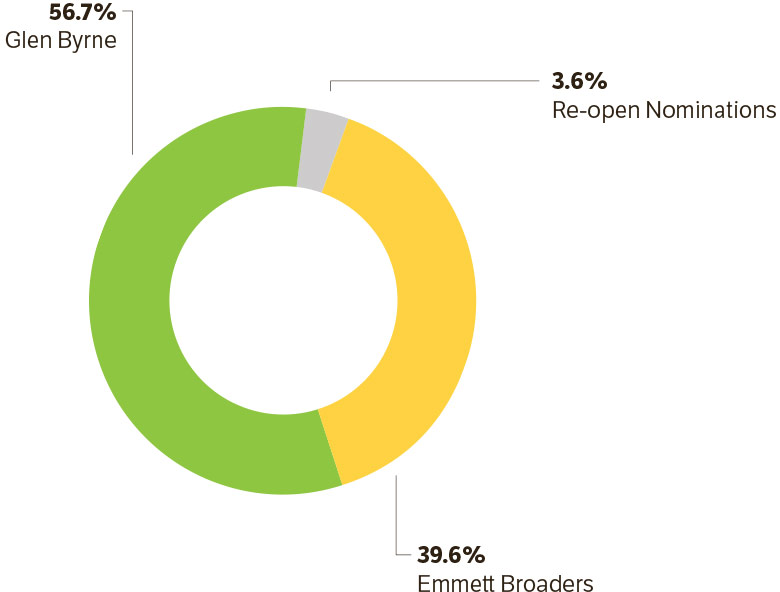
Byrne appears to be the most popular candidate across all three faculties, scoring over 50 per cent of each area’s first-preference vote. In his native AHSS, Byrne is expect to take 57.2 per cent of the vote, followed closely behind by EMS at 57.1 per cent, and HS at 53.6 per cent. Re-open nominations remains high in AHSS, taking 3.7 per cent of the first preference vote. Broaders, on the other hand, fares best among HS students, gaining 40.6 per cent of the final tally but dropping to 40.4 among EMS students and again to 39.1 per cent among AHSS.
In a breakdown of year cohorts, Byrne proves to be extremely popular among fourth-year students, expected to secure 81.4 per cent of their first preference vote – an enormous win over Broaders’s expected 16.3 per cent. Byrne’s weakest year is second year, which is actually Broaders’s strongest, where they are both level on 48.5 per cent of the vote. Re-open nominations is highest among first-year students, where it could take almost four per cent of the vote.
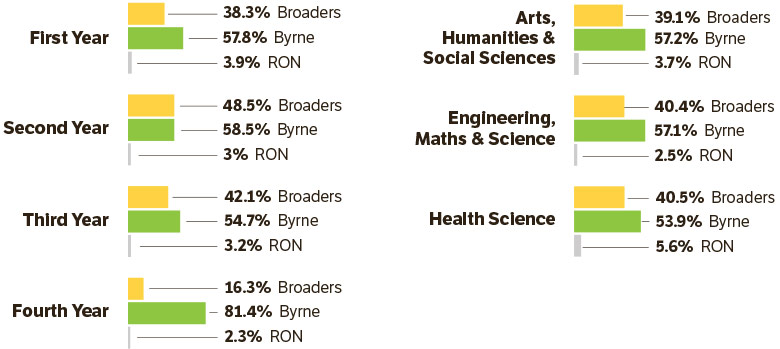
Last year saw current officer, Aifric Ní Chríodáin, gain 61.3 per cent of the vote, with her opponent Jemma O’Leary taking 34.4 per cent. Re-open nominations was quite tight, at 4.2 per cent. Polling results at the time saw Ni Chríodáin take less than what she originally gained – but within the margin of error – but still have a comfortable lead over O’Leary. As such, it would take a large change in voter opinion for Broaders to secure a lead over his opponent.
Both Broaders’s and Byrne’s campaigns have been extremely visible over the campaign period, with little clashing of heads during the hustings. Byrne, however, appears to have been more well-versed in some areas than his opponent, especially in LGBT issues, stating that he would effectively represent the LGBT community, whilst Broaders argued that one “can’t be 100 per cent representative of anyone else”. Byrne has had a strong social media presence, with a an identifiable media brand. Broaders has also had a good presence online but was hit with a fine early on in the race after using his page “TCD Facts” to endorse his campaign page.
Ents
The ents race looks to be the tightest of this year’s TCDSU elections, with third-year computer science student Padraic Rowley predicted to prevail in a tense race which predicts the race to go to three round, in a tight race between Rowley and second-year earth science student Caolán Maher.
Close First Count, with Rowley Ahead
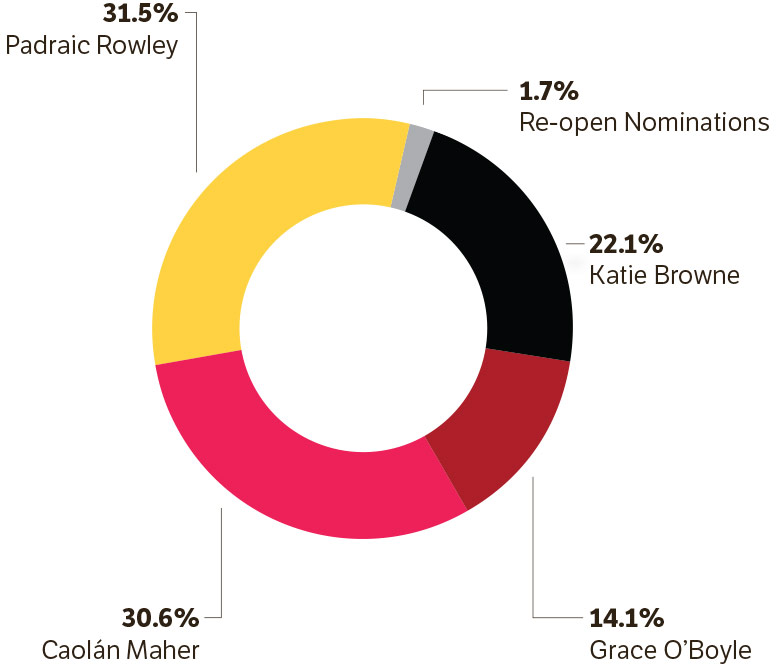
Excluding the 302 students who opted for don’t know, who again are likely to split marginally in favour of the front runner if they vote, the first round is expected to be a remarkably tight race between Rowley and Maher. Rowley is predicted to take 31.5 per cent of the vote to Maher’s 30.5 per cent, in an intensely fought race which has seen rather different results across both faculties and year groups. Coming in third in the poll is Katie Browne with 22.1 per cent of the vote, and Grace O’Boyle further back on 14.1 per cent of the vote – with the remaining 1.7 per cent pledging to vote to re-open nominations.
Transfer analysis shows that in the second round, after the elimination of O’Boyle and re-open nominations, Rowley looks set to extend his lead over Maher – increasing his vote share to 38.86 per cent – after taking 52.5 per cent of O’Boyle’s second preferences, with Maher trailing behind on 34.7 per cent on the second count. Browne continues to trail on 26.4 per cent of the vote in the second round.
In Final Round, Rowley Grabs Most Transfers
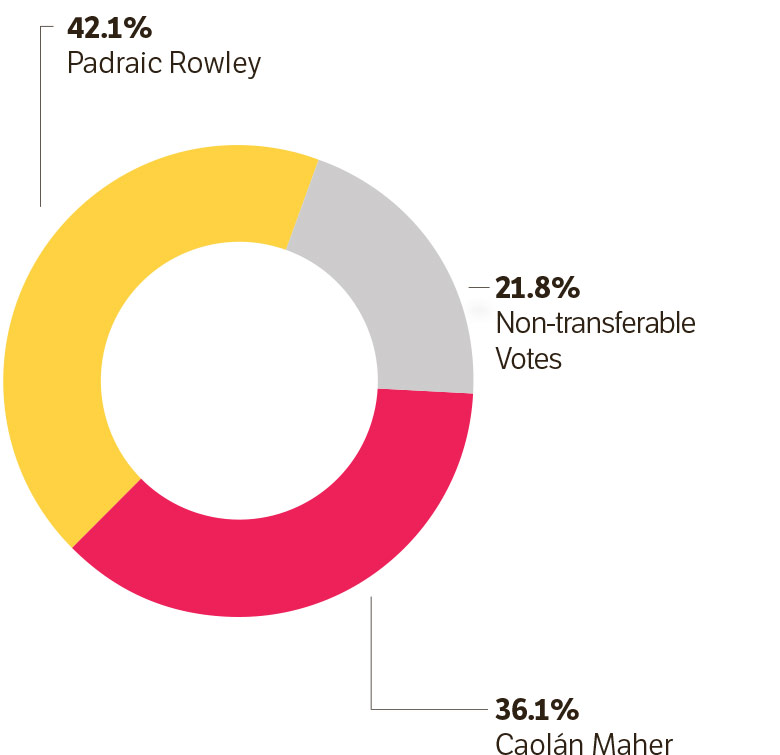
The transfer friendliness of Rowley continues into the final round after the elimination of Browne, with final figures predicting Rowley to win a the tight race with a total vote share of around 42.8 per cent to Maher’s 36.7 per cent. Taking into account just votes in the final round – which excludes non-transferable votes from earlier rounds – Rowley comes away with 53.8 per cent of the total, while Maher comes away with 46.2 per cent. This is reflective of the tight nature of the race throughout campaign week – and the fact that the overall race is coming right down to the wire is unsurprising, mirroring last year’s ents race in what should be a just as tense evening for all candidates involved.
Further highlighting the tight nature of the race, the votes are distributed incredibly unevenly across year groups.
Maher is the preferred candidate amongst first and second-year students, polling 47.7 per cent amongst first years, and 38.7 per cent amongst second years, compared to Rowley’s figure of 26.4 per cent and 21.3 per cent in those groups, respectively. Browne rather interestingly is quite strong amongst second years – polling in second place on 26.8 per cent, although this is not reflected in first-year groups, with 13.21 per cent of these voters pledging their votes to Browne. Further back is O’Boyle who finds herself polling in fourth place in both the first and second year groups.
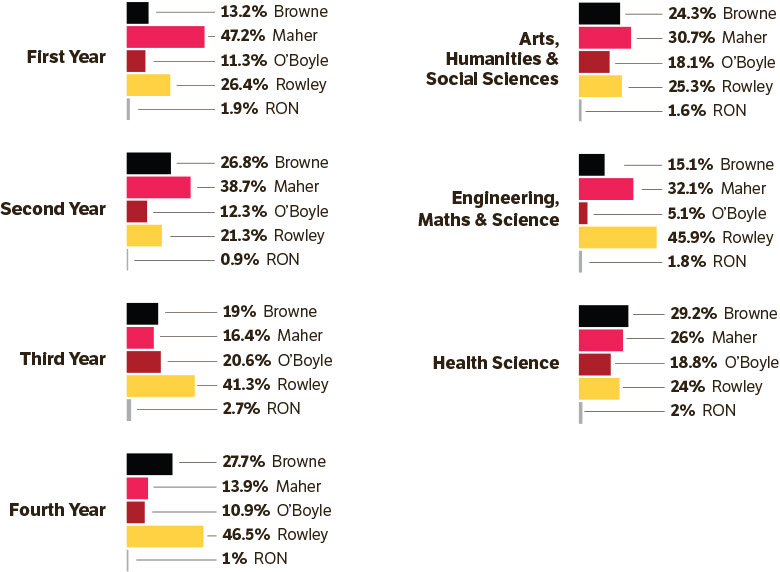
Amongst older years, an entirely different story is prevalent, with Rowley proving to be immensely popular, and Maher polling in fourth place amongst third years, and third amongst fourth years. Rowley holds commanding leads over all candidates in both of these constituencies, with 41.27 per cent and 46.53 per cent of third and fourth years pledging their vote to him in comparison to Browne’s 19 per cent and 27.7 per cent and O’Boyle’s 20.6 per cent and 10.89 per cent in these years.
Indeed, this illustrates a great degree of divide amongst the college community within this race – and perhaps highlights the different issues which drive different years. The fact that Maher is a second-year candidate and Rowley is a fourth year can perhaps emphasise the importance of influence amongst year groups.
On a faculty basis, a similar story is told, with Caolán leading amongst AHSS students – taking 30.8 per cent of the votes and enjoying a lead over Rowley on 25.3 per cent and Browne on 24.3 per cent in the same constituency, with the poll propped up by O’Boyle on around 18 per cent. In his home constituency of EMS, Rowley enjoys a comfortable lead with 45.9 per cent of the vote – with Maher also polling highly on 32.11 per cent – suggesting the EMS-based duo look set to dominate the poll at the Hamilton end of campus, with O’Boyle and Browne significantly further back.
Clear leads are not present in the HS faculty however, with voters there appearing to be evenly spread amongst candidates: Katie Browne leads on 29.2 per cent, followed by Maher on around 26 per cent and Rowley on 24 per cent, with O’Boyle once again in fourth place in this constituency – not too far behind the other candidates. Indeed this suggests that there is no particular preference amongst these voters, and that it could come down to the effects of last-minute work on the ground to convince them.
Most interestingly, the voting patterns did not change between Thursday or Friday, suggesting that Maher was unaffected by a University Times story which said that he was handing out free cans in Trinity Hall.
Overall, the poll suggests that Rowley is set to win on his transfer friendliness, but this could well come down to the final days of campaigning. Indeed this race has given the indication of being the tightest race throughout, and the final days of the campaign will be essential as the campaign entering the final days. Within this race every last vote will count, and any major change in trends could upset the balance of what is set to be a tightly contested contest. It may well go on into the early hours of Friday morning in the count centre.
Editor of The University Times
Uncontested candidate Sinéad Baker looks set to become the next editor of The University Times, taking a comfortable 91.2 per cent of the vote, staving off competition from re-open nominations, which looks set to gain 8.7 per cent of first-preference votes. The results are expected to be not unlike that of her predecessor, Edmund Heaphy, who took 88 per cent of the total first-preference votes in last year’s race. Baker’s success is not surprising given the fact her position is uncontested, yet the results reflect her good presence both on the ground and on social media. Baker’s ideas have been generally well received, promising to focus strongly on the newspaper’s staff, especially on improving the training and support they are given. She also stressed the importance of how The University Times should provide a platform for students’ views.
Baker’s performances at hustings have been generally well received, especially when asked about the criticism of the The University Times’s current election coverage, stating that “there has been coverage that has been unfair” but that she did not “perceive a bias this year”. She also appeared to suggest that processes were not being followed within the newspaper which would allow editors to “question” themselves when it came to being fair.
Conor Parle and Edmund Heaphy conducted data analysis, cross tabulation and modelling.
Edmund Heaphy, Eleanor O’Mahony, Stephen Burke and Dominic McGrath also contributed analysis to this piece. John Conway, Emer Gerrard, Nora Donnelly, Jack Hartnett, Aoife O’Donoghue, Ciaran Sunderland, Charlotte Ryan, Anna Moran, Dominic McGrath, Eleanor O’Mahony, Edmund Heaphy, Sinéad Loftus and Niamh Egleston conducted polling.
Polling Methodology: The University Times polled 1,007 Trinity students in campus and off-campus locations on Wednesday, Thursday and Friday of last week, including in the Arts Block, Hamilton, GMB, the Buttery, Goldsmith Hall, Biomedical Science Building and D’Olier St and St James’s Hospital. Our data collection was tailored to take into account predicted voting patterns, with an expected increase in turnout amongst Health Science students thanks to third-year medical student Aoibhinn Ní Lochlainn, who is running for Welfare & Equality Officer. The margin of error is approximately plus-or-minus three per cent, based on a 95 per cent confidence interval. The sample size is quite large when the expected turnout is unlikely to broach 5,000 voters, but because the sample can never be completely random, it is difficult to push the margin of error lower. Despite this, previous polls from The University Times have always successfully predicted the outcome of even close races, and within the margin of error. Based on advice from political scientists and experienced pollsters considering the circumstances of a student election, The University Times does not ask if those polled are likely to vote, but instead takes this into account during the distribution of undecided votes.






